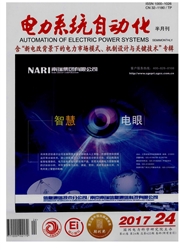

 中文摘要:
中文摘要:
促进可再生能源消纳、提高能源综合利用效率是电力和热力等能源系统可持续发展的重要途径。针对电力和热力两种异质能源系统在传统研究对象和分析方法上的差异性,引入理论,结合热电比拟方法,从热量输运的驱动力和阻抗的角度揭示了热系统中基本元件的本构关系,并从能量流的视角对其重新建模,结合热系统的拓扑结构,提出热系统的能量流模型来描述系统中热量的整体输运规律。在此基础上,同时考虑电—热综合能源系统中的能量平衡特性和热量输运的不可逆性,提出了电—热综合能源系统的整体能量流模型,统一了电能传输和热能输运的研究视角,揭示了系统中能量的整体输运规律。最后,针对一个简单的电—热综合能源系统,以最小化系统总煤耗为目标,应用能量流和互为边界的方法分别预测了风电出力情况,结果表明能量流法预测的风电出力更准确,从而验证了能量流法的可行性和必要性。
 英文摘要:
英文摘要:
Improvement of renewable energy accommodation and energy utilization efficiency are both promising channels for sustainable development of electric and thermal energy systems, In view of the difference in the study subject and the analytic method, the constitutive relation between the basic components in the thermal system is revealed from the perspective of heat transport. By introducing the entransy theory and analogy between electricity and heat in transmission, an alternative model is developed from the angle of energy flow by considering the driving force and thermal resistance in heat transfer. Together with the topological structure, the energy flow model of the thermal system is developed to describe the law of integral heat transport. On this basis, the energy flow model of the electric-thermal integrated energy system in consideration of energy conservation and heat transfer irreversibility at the same time. This will unify the study perspective of electric and thermal energy in transmission while laying bare the law of integral energy transport. Finally, a simple integrated energy system is employed to minimize the total coal consumption by using the energy flow method and the dual boundary method, respectively, The results show that the predicted wind power generation with the energy flow method is more accurate, which shows the feasibility and necessity.
 同期刊论文项目
同期刊论文项目
 同项目期刊论文
同项目期刊论文
 期刊信息
期刊信息
